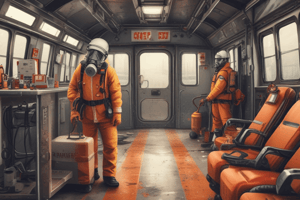Podcast
Questions and Answers
What type of contamination involves direct exposure to hazardous materials?
What type of contamination involves direct exposure to hazardous materials?
- Environmental Contamination
- Tertiary Contamination
- Primary Contamination (correct)
- Secondary Contamination
Which factor is primarily associated with increased bodily effects from toxin exposure?
Which factor is primarily associated with increased bodily effects from toxin exposure?
- Duration of contact (correct)
- Nature of the toxin
- Time of day of exposure
- Color of the toxin
What are systemic effects of hazmat exposure likely to impact?
What are systemic effects of hazmat exposure likely to impact?
- Internal organs (correct)
- Muscle and bone
- Digestive system only
- Skin and hair
During the cycle of poison action, which process occurs first?
During the cycle of poison action, which process occurs first?
What type of documentation is essential for a medical director following hazmat exposure?
What type of documentation is essential for a medical director following hazmat exposure?
What is the primary purpose of establishing safety perimeters during a hazmat incident?
What is the primary purpose of establishing safety perimeters during a hazmat incident?
In which zone does decontamination primarily occur?
In which zone does decontamination primarily occur?
Which level of personal protective equipment offers the highest degree of respiratory and skin protection?
Which level of personal protective equipment offers the highest degree of respiratory and skin protection?
What does the green section of the Emergency Response Guide (ERG) primarily provide?
What does the green section of the Emergency Response Guide (ERG) primarily provide?
What is the role of Cameo software in hazmat incidents?
What is the role of Cameo software in hazmat incidents?
Which of the following routes of exposure is considered most critical in a hazmat situation?
Which of the following routes of exposure is considered most critical in a hazmat situation?
What is one aspect that NFPA standards do not cover regarding PPE?
What is one aspect that NFPA standards do not cover regarding PPE?
Which level of PPE is appropriate for use in the Cold Zone with minimal threats?
Which level of PPE is appropriate for use in the Cold Zone with minimal threats?
Study Notes
Safety Zones in Hazmat Incidents
- Establish safety perimeters based on toxicity levels and fire/explosion risks.
- Protect self first, isolate the incident using resources like the Emergency Response Guide (ERG) and wind direction.
- Notify dispatch and other responders with observations on the scene.
Hazmat Zones
- Hot Zone: Contamination area, access restricted to trained responders with appropriate PPE.
- Warm Zone: Surrounds the Hot Zone; where decontamination takes place, also restricted to trained personnel.
- Cold Zone: Safe area for triage and treatment, acts as a buffer from hazards.
Evacuation and Initial Response
- ERG's green section offers evacuation distances and basic action plans based on chemical spill size.
- Hazmat teams use air monitoring for explosive limits and gas concentrations, including hydrogen sulfide and carbon monoxide.
Detection and Monitoring Equipment
- Utilize colorimetric devices for specific agent testing and determining pH of spills.
- Cameo software predicts downward concentrations and vapor cloud direction based on environmental factors.
Personal Protective Equipment (PPE)
- Determine appropriate PPE through Hazmat specialists.
- Level A: Maximum respiratory and skin protection with full body coverage and SCBA; manages heat stress.
- Level B: High respiratory protection without skin absorption threat; worn with SCBA, not fully encapsulating.
- Level C: Minimal splash protection for known substances; can include APR or powered APRs.
- Level D: Basic dust mask; used in Cold Zone with minimal threat from substances.
PPE Standards and Regulations
- NFPA standards provide guidance on PPE manufacturing quality, not on responder actions.
- OSHA’s WHPP regulations offer guidance on chemical protection levels.
Toxicology and Exposure
- Hazmat exposure can disrupt bodily processes, influenced by:
- Route of exposure (ingestion, inhalation, injection, absorption).
- Dose and concentration of the toxin.
- Duration of contact and patient’s health status.
Contamination Types
- Primary Contamination: Direct exposure to hazardous materials.
- Secondary Contamination: Transfer of hazardous material from one person or object to another.
Effects of Hazmat Exposure
- Localized effects include skin irritation or blistering.
- Systemic effects impact internal organs (neurological, renal, hepatic) and can manifest immediately or after a delay.
Documentation and Treatment Records
- Document observations for medical director, scene description, patient appearance, treatments rendered, and changes post-exposure.
- Apply dose-effect principle: greater exposure duration or concentration correlates with increased bodily effects.
- The cycle of poison action includes absorption, delivery to target organs, binding, biotransformation, and elimination through GI and respiratory systems.
Safety Zones in Hazmat Incidents
- Safety perimeters are established according to toxicity levels and fire/explosion risks.
- Prioritize personal safety; isolate the incident using the Emergency Response Guide (ERG) and monitor wind direction.
- Communicate critical observations to dispatch and other responders.
Hazmat Zones
- Hot Zone: Access is restricted to trained responders equipped with proper personal protective equipment (PPE); area is contaminated.
- Warm Zone: Surrounds the Hot Zone; designated for decontamination, restricted access for trained personnel only.
- Cold Zone: Safe area for triage and treatment; serves as a buffer from contamination hazards.
Evacuation and Initial Response
- The green section of the ERG provides evacuation distances and action plans tailored to spill size.
- Hazmat teams perform air monitoring to assess explosive limits and gas concentrations, including hazards like hydrogen sulfide and carbon monoxide.
Detection and Monitoring Equipment
- Colorimetric devices are employed for testing specific agents and measuring pH levels of spills.
- Cameo software forecasts vapor cloud movement and concentration levels, influenced by environmental conditions.
Personal Protective Equipment (PPE)
- Appropriate PPE is determined by Hazmat specialists based on incident specifics.
- Level A: Full body coverage with maximum respiratory and skin protection, used in high-risk environments; manages heat stress with SCBA.
- Level B: Offers high respiratory protection without risk of skin absorption; worn with SCBA but not fully encapsulating.
- Level C: Provides minimal splash protection for known substances; may involve air-purifying respirators (APR) or powered APRs.
- Level D: Basic dust mask suitable for Cold Zone operations where threat levels from hazardous substances are minimal.
PPE Standards and Regulations
- NFPA standards ensure manufacturing quality of PPE but do not govern responder actions.
- OSHA’s Water and Hazardous Materials Protection (WHPP) regulations outline chemical protection levels for responders.
Toxicology and Exposure
- Hazmat exposure can impair bodily functions depending on multiple factors:
- Route of exposure (ingestion, inhalation, injection, absorption).
- Dose and concentration of the hazardous substance.
- Duration of exposure and the individual’s health status.
Contamination Types
- Primary Contamination: Occurs from direct exposure to hazardous materials.
- Secondary Contamination: Involves the transfer of hazardous materials from one person or object to another.
Effects of Hazmat Exposure
- Localized effects can lead to skin irritation or blistering.
- Systemic effects can affect major organs (neurological, renal, hepatic) and symptoms may appear immediately or after a delay.
Documentation and Treatment Records
- Thorough documentation includes observations for the medical director, scene details, patient condition, treatments administered, and changes post-exposure.
- The dose-effect principle states that longer exposure duration or higher concentration correlates with more severe health impacts.
- The cycle of poison action involves: absorption, transport to target organs, binding, metabolism (biotransformation), and elimination through gastrointestinal and respiratory systems.
Studying That Suits You
Use AI to generate personalized quizzes and flashcards to suit your learning preferences.
Description
Test your knowledge on safety zones during hazmat incidents, including the Hot, Warm, and Cold Zones. The quiz covers essential procedures for establishing safety perimeters, notification protocols, and the use of detection equipment in emergency situations.




